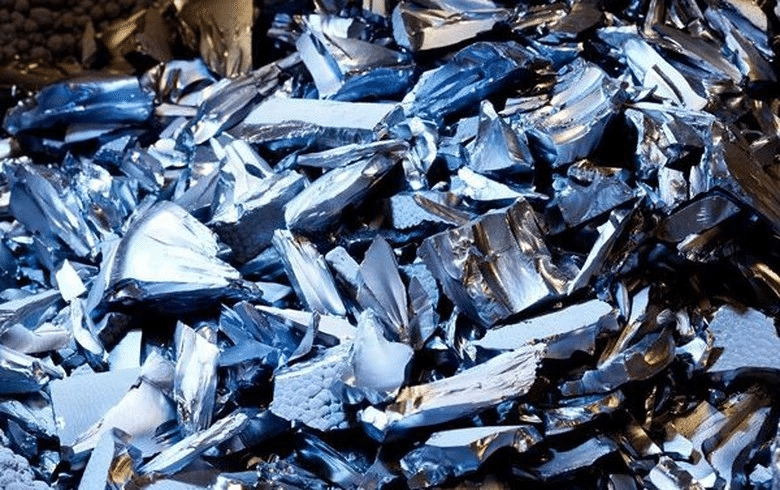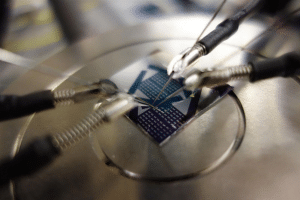
Polycrystalline silicon thin film丨reasons affecting the warpage of silicon wafers

In many cases, stress can introduce many undesired results. The outstanding problem with utilizing LPCVD deposited polysilicon films for debris absorption is that the stresses within the film can cause a large degree of warpage in the wafer.
Reasons affecting wafer warpage
Effect of deposition temperature on wafer warpage
The warpage of wafers with thin film deposited is much larger than that of wafers without thin film deposited after polishing, and the warpage of wafers becomes smaller as the temperature of thin film deposition increases.
First of all, because the polysilicon film is double-sided deposition, after polishing the single-sided film is removed, due to the role of the film's internal stress, the degree of its soaring curvature is bound to increase.
Secondly, according to the stress theory analysis, the residual stress of polysilicon film has a great relationship with its microstructure, which has a strong dependence on the deposition conditions. At low temperature, the deposition rate is slow, due to the role of the very small kinetic energy of silicon atoms, which will cause them to nucleate at the boundary of the smaller fine grains, the weak bonding between the film and the substrate produces small tensile stresses, and the vacancies, defects, etc., will also be a source of stress. As the deposition temperature increases, the kinetic energy increases, prompting the formation of islands and agglomeration to form larger nuclei, causing a reduction in volume and an increase in stress, leading to compressive stress. Further increase in temperature, surface energy and grain growth, diffusion of atoms between inter-grain boundaries and increase in compressive stress. When deposited between 580 and 610°C, the interior of the film can be transformed from tensile to compressive stress. When the temperature continues to rise, the grains grow into columns, the atoms extend the vertical direction of growth, and the compressive stress gradually decreases. Because the direction of the sample bending is the same, it can be seen that, within a certain temperature range, the film internal are manifested as compressive stress and with the increase in temperature, the compressive stress decreases.
In addition, because there is no additional stress imposed by other films during polysilicon deposition, the total stress of the film can be simplified as the sum of the internal and thermal stresses, of which the temperature is the main factor affecting the thermal stresses, and an increase in the deposition temperature will result in an increase in the internal stresses of the film.
It can be seen that the polycrystalline silicon films deposited at high temperatures obtain relatively small wafer warpage values, proving that the total stress of the films is mainly affected by the internal stress, which is strongly dependent on the temperature change. Therefore, under the condition that the surface quality meets the requirements, an appropriate increase in the deposition temperature can improve the warpage of silicon wafers.
Effect of film thickness on wafer warpage
Much of the resultant change in warpage with film thickness may be related to the evolution of internal stresses in film growth. The film is initially subjected to compressive stresses, which then gradually change to tensile stresses and finally back to compressive stresses. This behavior is closely related to the growth process during the deposition phase of the film. In the initial stage, the film grows as discrete clusters or islets on the substrate surface, and these islets typically exhibit compressive stresses due to surface or interfacial stresses that reduce the lattice gap between the relatively very small individual grains. In the second stage, the islands grow so that island-to-island contact begins to occur, leading to the formation of grain boundaries and therefore causing the tensile stresses in the film to begin to increase. The aggregation of islands as a reverse elastic fracture mechanism, the intergranular boundary is considered as a crack, and the system can reduce its free energy by approaching this crack by replacing the high surface energy by a lower interfacial energy. By approaching the crack or grain boundary, the film material is subjected to tensile stress. In the third stage, as the thickness of the film increases, the surface atoms are transferred to the intergranular boundaries, forming a continuous film, and the film stress begins to decrease, gradually changing from tensile stress to compressive stress, which increases with the thickness. In addition, since the reaction conditions are identical except for the different deposition thicknesses, it is known that the thermal stresses of the films are the same. Therefore, the total stress change is determined by the internal stress of the film.
There is a tendency for the warpage of the substrate wafers to become smaller with increasing film thickness. This is in good agreement with the third stage of the film internal stress evolution during the growth process. Therefore, the warpage of the substrate wafers will still decrease with further increase of film thickness under certain conditions.
Effect of annealing process on warpage of polycrystalline back-sealed wafers
Effect of annealing temperature on warpage of polycrystalline back-sealed wafers
After double-sided deposition of multi-product silicon films on the surface of acid-etched wafers using the LPCVD method, the warpage of the wafers before and after annealing was basically unchanged. After one-sided polishing, the warpage of the substrate wafer increased significantly. However, with the increase of annealing temperature, the warpage tends to decrease. 1000℃ is the critical point of the drastic change of warpage, and annealing higher than 1000℃ can realize the effective control of warpage.
During thin film growth, low process temperatures result in reduced surface diffusion, making it impossible for absorbed silicon atoms to be embedded in the lowest energy equilibrium. For this reason, films in the as-deposited state have many point defects, vacancies, dislocations, intergranular boundaries, accumulated stresses, etc. As the annealing temperature increases, the vacancies become movable and drift into the dislocations, which are also activated and move to the free surface by creep and slip, releasing the stresses. As the defect density decreases, the entire film becomes dense. Grain growth and accompanying re-nucleation, driven by surface energy, continues during annealing. As the grains grow, the smaller sized grains are consumed by neighboring larger sized grains, gradually making their body surface area ratio larger. Consequently, as the annealing temperature increases, the stress relief within the film increases and the warpage of the wafer decreases.
Effect of annealing time on warpage of polycrystalline back-sealed wafers
When the annealing temperature is 900°C, the warpage of the wafers decreases with the annealing time but the amount of change also decreases. At annealing temperatures of 1000°C and 1100°C, the warpage of wafers changes very little with annealing time. However, under the same conditions, the warpage at 1000℃ is slightly larger than that at 1100℃, and the difference between the two is larger at 900℃. When the annealing temperature is low, the atomic movement is relatively slow, the stress release is more delayed, appropriate increase in annealing time can make the atom move a longer distance to reach the stress release point, can make the warpage slightly improved. The temperature of annealing is very favorable to the improvement of warpage. As the annealing temperature increases, the surface diffusion becomes intense and the residual stresses are eliminated. For multi-product silicon film, annealing above 1000℃ for 60min can basically release the stress and obtain a better warpage.
Due to the different film preparation process, heat treatment process and film thickness requirements, resulting in different stress states within the film, the geometric parameters of the deposited film after substrate polishing also have different sizes. Therefore, it is possible to properly select the process conditions of film preparation and heat treatment process to realize the control of film residual stress, and at the same time, according to the different film thickness requirements, roughly deduce the change of the warpage after substrate polishing, so as to appropriately assess the processing capability of the product. The specific conclusions are as follows.
1, under the same conditions, with the temperature of film deposition increases, the warpage of the silicon wafer gradually becomes smaller. At higher deposition temperatures, the substrate wafer warpage value is relatively small.
2. The warpage of the substrate wafer tends to become smaller with increasing film thickness. This is in good agreement with the third stage of the evolution of the internal stresses in the film during the growth process. Therefore, we can infer that the warpage of the substrate wafers will still decrease with the further increase of the film thickness.
3, with the annealing temperature increases, the warpage of the substrate wafer tends to decrease. 1000 ℃ or so is the critical point of warpage drastic changes, higher than 1000 ℃ annealed for 60min can realize the effective control of the warpage.
We offer Chemical Vapor Deposition (CVD) OEM Customization Services, Feel free to leave a message to inquire.
Physical Vapor Deposition (PVD) Classification, Characteristics, and Applications
Classification, Characteristics, and Applications of Physical Vapor Deposition (PVD) Physical Vapor
Electron Beam Evaporation Coating (EB-PVD) Processes and Advantages and Disadvantages
Processes and Advantages of Electron Beam Evaporation Coating (EB-PVD) Electron Beam
Exploring 4 applications of silicon nitride thin-film windows in bioscience
This paper will describe the properties and advantages of silicon nitride thin film windows and discuss four common applications in the life sciences.



.jpg)